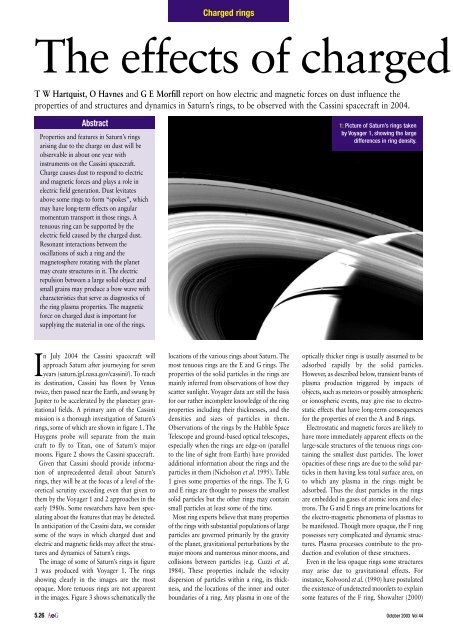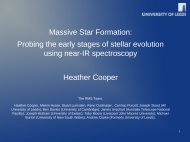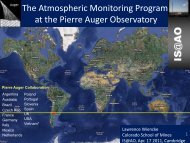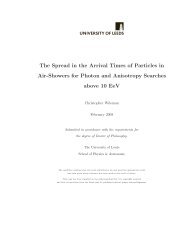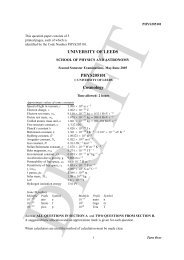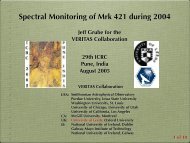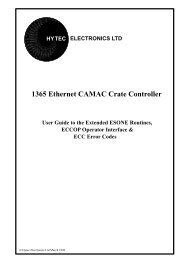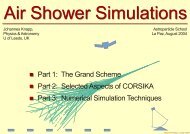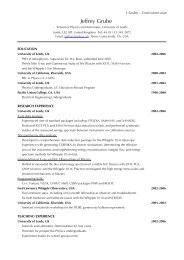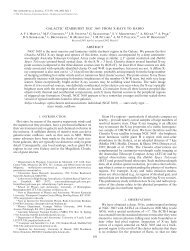The Effects of Charged Dust on Saturn's Rings - University of Leeds
The Effects of Charged Dust on Saturn's Rings - University of Leeds
The Effects of Charged Dust on Saturn's Rings - University of Leeds
You also want an ePaper? Increase the reach of your titles
YUMPU automatically turns print PDFs into web optimized ePapers that Google loves.
<str<strong>on</strong>g>Charged</str<strong>on</strong>g> ringscalculate Z g . <str<strong>on</strong>g>The</str<strong>on</strong>g> self-c<strong>on</strong>sistent calculati<strong>on</strong> <str<strong>on</strong>g>of</str<strong>on</strong>g>the magnitude <str<strong>on</strong>g>of</str<strong>on</strong>g> Z g gives a smaller value thanobtained with equati<strong>on</strong> 1. A cloud <str<strong>on</strong>g>of</str<strong>on</strong>g> small dustparticles will also be charged up by the plasma,resulting in an electric field throughout the dustcloud which leads to a lifting force (or electrostaticpressure) <strong>on</strong> the charged dust. <str<strong>on</strong>g>The</str<strong>on</strong>g> magnitude<str<strong>on</strong>g>of</str<strong>on</strong>g> this electrostatic lifting force peakswhen the parameterP = k B Tn g r g / n e0 e 2 (3)(Havnes et al. 1990) is <str<strong>on</strong>g>of</str<strong>on</strong>g> the order <str<strong>on</strong>g>of</str<strong>on</strong>g> 1. Heren e0 is the electr<strong>on</strong> density above or below thering and n g is the dust density. For P 1P ≈ n g Z g / n i Z i (4)In subsequent secti<strong>on</strong>s we describe the formati<strong>on</strong><str<strong>on</strong>g>of</str<strong>on</strong>g> spokes and self-c<strong>on</strong>sistent models <str<strong>on</strong>g>of</str<strong>on</strong>g> electrostaticallysupported rings where P is notnegligible. In c<strong>on</strong>trast, when P is small, interesting“test particle” resp<strong>on</strong>ses <str<strong>on</strong>g>of</str<strong>on</strong>g> grains to magnetosphericelectric and magnetic effects occur.Such resp<strong>on</strong>ses are important in the E ring.Spokes – evidence for the electrostaticsupport <str<strong>on</strong>g>of</str<strong>on</strong>g> dustSpokes were discovered in Saturn’s B ring withthe Voyager instruments (e.g. Eplee and Smith1984, 1985). <str<strong>on</strong>g>The</str<strong>on</strong>g>y are seen as dark shadows <strong>on</strong>the opaque ring. A single spoke can form <strong>on</strong> theilluminated side <str<strong>on</strong>g>of</str<strong>on</strong>g> the ring and then grow andsurvive as the ring material orbits to the darkside <str<strong>on</strong>g>of</str<strong>on</strong>g> the planet. Figure 4 c<strong>on</strong>tains images <str<strong>on</strong>g>of</str<strong>on</strong>g> therings when spokes were present and evolving.<str<strong>on</strong>g>The</str<strong>on</strong>g> shadows are cast by submicr<strong>on</strong>-sized dustlifted above the B ring. <str<strong>on</strong>g>The</str<strong>on</strong>g> small dust grains aremost likely produced by the impact <str<strong>on</strong>g>of</str<strong>on</strong>g> objects,including meteors, <strong>on</strong> the larger solid particlesin the rings. An impact also produces plasma,and the grains become charged, as describedabove. Electrostatic forces can lift the smallgrains to form the spokes (Goertz and Morfill1983, Morfill et al. 1983). <str<strong>on</strong>g>The</str<strong>on</strong>g> electric fieldarises as a c<strong>on</strong>sequence <str<strong>on</strong>g>of</str<strong>on</strong>g> the i<strong>on</strong>s, which arelight and hot, having a larger gravitati<strong>on</strong>al scaleheight than the supermicr<strong>on</strong>-sized solid particles.<str<strong>on</strong>g>The</str<strong>on</strong>g>se larger solid particles, just as the submicr<strong>on</strong>-sizedparticles do, carry negative charge.Thus, there is some charge separati<strong>on</strong>.A prime advantage <str<strong>on</strong>g>of</str<strong>on</strong>g> a spokes model inwhich electrostatic support plays a role is thatelectrostatic support occurs for grains <strong>on</strong>ly upto a certain size. Scattering properties <str<strong>on</strong>g>of</str<strong>on</strong>g> grainsin the spokes indicate that they are probablysubmicr<strong>on</strong> in size. A purely gravitati<strong>on</strong>al mechanismwould not be size-selective and would liftlarger particles as well.A dust particle elevated above a ring resp<strong>on</strong>dsto the Lorentz force due to its moti<strong>on</strong> withrespect to the planetary magnetic field. Let r syndenote the radius <str<strong>on</strong>g>of</str<strong>on</strong>g> synchr<strong>on</strong>ous orbit, whichis the radius at which the Keplerian orbitalperiod around the planet is the same as the rotati<strong>on</strong>period <str<strong>on</strong>g>of</str<strong>on</strong>g> the planet. At radii less than r synthe dust moves faster than the magnetic fieldlines, which rotate around the planet with theperiod at which the planet spins. At greaterradii the dust moves more slowly. <str<strong>on</strong>g>The</str<strong>on</strong>g> Lorentzforce drives the dust initially bey<strong>on</strong>d r syn togreater radii and drives the dust initially nearerto the planet than r syn to smaller radii. Thus, thespokes move radially as well as they orbit theplanet. <str<strong>on</strong>g>The</str<strong>on</strong>g>y have been described as hydromagneticwaves (Tagger et al. 1991).<str<strong>on</strong>g>The</str<strong>on</strong>g> radial moti<strong>on</strong> causes angular momentumtransport, which may have substantial effects<strong>on</strong> the structure <str<strong>on</strong>g>of</str<strong>on</strong>g> the B ring (Goertz et al.1986, Shan and Goertz 1991). Angular momentumis transferred inwardly at radii greaterthan r syn and outwardly at radii smaller thanr syn giving rise to a tendency <str<strong>on</strong>g>of</str<strong>on</strong>g> the ring tobecome more extended. <str<strong>on</strong>g>The</str<strong>on</strong>g> outer boundary <str<strong>on</strong>g>of</str<strong>on</strong>g>the B ring is probably limited by a gravitati<strong>on</strong>alinteracti<strong>on</strong> with the mo<strong>on</strong> Mimas which orbitswith twice the period at which the outerboundary <str<strong>on</strong>g>of</str<strong>on</strong>g> the B ring orbits. Angular momentumis transferred to that mo<strong>on</strong> in the res<strong>on</strong>ateinteracti<strong>on</strong> between it and the outer B ringboundary, halting the outward expansi<strong>on</strong> <str<strong>on</strong>g>of</str<strong>on</strong>g>the ring material.Various features in the B ring may originatedue to the transport <str<strong>on</strong>g>of</str<strong>on</strong>g> material and angularmomentum away from r syn by the spokes. Forinstance, a minimum in the opacity <str<strong>on</strong>g>of</str<strong>on</strong>g> the ringexists just bey<strong>on</strong>d r syn . An instability in thering’s density distributi<strong>on</strong> is associated with thematerial and angular momentum transport inthe spokes, and the existence <str<strong>on</strong>g>of</str<strong>on</strong>g> observedringlets in the B ring may be due to it (Goertzand Morfill 1988, Shan and Goertz 1991).<str<strong>on</strong>g>The</str<strong>on</strong>g> A ring may well have spokes that wereundetectable with the Voyager instruments. If itdoes or has had significant spoke activity in thepast, the spokes have almost certainly also hadeffects <strong>on</strong> its structure and features.Electrostatically supported rings<str<strong>on</strong>g>The</str<strong>on</strong>g> typical solid particle size in some <str<strong>on</strong>g>of</str<strong>on</strong>g>Saturn’s rings is about a micr<strong>on</strong> or less. <str<strong>on</strong>g>The</str<strong>on</strong>g>rings with small solid particles also c<strong>on</strong>tainplasma as Voyager data dem<strong>on</strong>strated(Richards<strong>on</strong> and Sittler 1990). <str<strong>on</strong>g>The</str<strong>on</strong>g> number density<str<strong>on</strong>g>of</str<strong>on</strong>g> electr<strong>on</strong>s varies with distance from theplanet and height about the ring midplane butis typically within an order <str<strong>on</strong>g>of</str<strong>on</strong>g> magnitude <str<strong>on</strong>g>of</str<strong>on</strong>g>1–10 cm –3 away from the most opaque rings.Because plasma is present and the solid particlesizes are small, Havnes and Morfill (1984) suggestedthat electrostatic support <str<strong>on</strong>g>of</str<strong>on</strong>g> dust grainsis important in at least some tenuous planetaryrings and that it can be the main mechanismdetermining the vertical thicknesses <str<strong>on</strong>g>of</str<strong>on</strong>g> somerings. <str<strong>on</strong>g>The</str<strong>on</strong>g> G ring, in particular, is likely to havea vertical structure (perpendicular to the ringplane) governed by a balance <str<strong>on</strong>g>of</str<strong>on</strong>g> electrostaticand gravitati<strong>on</strong>al forces.Havnes and Morfill (1984) c<strong>on</strong>structed a selfc<strong>on</strong>sistentmodel <str<strong>on</strong>g>of</str<strong>on</strong>g> the vertical structure <str<strong>on</strong>g>of</str<strong>on</strong>g> a4: <str<strong>on</strong>g>The</str<strong>on</strong>g> spoke phenomen<strong>on</strong> in the major rings(A and B) <str<strong>on</strong>g>of</str<strong>on</strong>g> Saturn.ring in which such a balance obtains. <str<strong>on</strong>g>The</str<strong>on</strong>g> inputparameters are the dust grain number densitiesat midplane, the i<strong>on</strong> density above the ring, themass per i<strong>on</strong>, the radius and mass <str<strong>on</strong>g>of</str<strong>on</strong>g> a dustgrain, the plasma temperature, and the distancefrom the planet. Obviously, the equati<strong>on</strong>sinclude the <strong>on</strong>e describing the balance betweenelectric force and gravitati<strong>on</strong> force <strong>on</strong> thegrains. <str<strong>on</strong>g>The</str<strong>on</strong>g> charge <strong>on</strong> a dust grain appearsin that equati<strong>on</strong> and is calculated <strong>on</strong> theassumpti<strong>on</strong> that the number <str<strong>on</strong>g>of</str<strong>on</strong>g> i<strong>on</strong>s striking agrain per unit time is equal to the number <str<strong>on</strong>g>of</str<strong>on</strong>g>electr<strong>on</strong>s striking it per unit time. (As describedearlier, in equilibrium a grain will acquire sufficientnegative charge for those collisi<strong>on</strong> ratesto be equal.) <str<strong>on</strong>g>The</str<strong>on</strong>g> number densities <str<strong>on</strong>g>of</str<strong>on</strong>g> i<strong>on</strong>sand electr<strong>on</strong>s are assumed to obey Boltzmannrelati<strong>on</strong>s, i.e.n α = n α0 exp(–Z α eV / k B T) (5)where the subscript α indicates which species isbeing c<strong>on</strong>sidered, the subscript 0 signifies thatthe value <str<strong>on</strong>g>of</str<strong>on</strong>g> the quantity is that obtaining whereV = 0, and V is the electric potential (the gradient<str<strong>on</strong>g>of</str<strong>on</strong>g> which times –1 gives the electric field)within the ring. <str<strong>on</strong>g>The</str<strong>on</strong>g> adopti<strong>on</strong> <str<strong>on</strong>g>of</str<strong>on</strong>g> equati<strong>on</strong> 5implies that the gravitati<strong>on</strong>al force <strong>on</strong> theplasma must be negligible. Though the electricfield balances the gravitati<strong>on</strong>al field, it isassumed to be sufficiently modest that the magnitude<str<strong>on</strong>g>of</str<strong>on</strong>g> the net charge density at any point(required to produce the electric field) is smallcompared to the magnitude <str<strong>on</strong>g>of</str<strong>on</strong>g> the charge densityassociated with any <str<strong>on</strong>g>of</str<strong>on</strong>g> the i<strong>on</strong>, electr<strong>on</strong>, ordust comp<strong>on</strong>ents. For a mixture <str<strong>on</strong>g>of</str<strong>on</strong>g> dust particleswith sizes between 1 µm and 1 cm the scaleheight <str<strong>on</strong>g>of</str<strong>on</strong>g> ring will be several tens <str<strong>on</strong>g>of</str<strong>on</strong>g> kilometresif the plasma number density and temperatureare about 10 cm –3 and 10 eV respectively.<str<strong>on</strong>g>The</str<strong>on</strong>g> two most important predicti<strong>on</strong>s <str<strong>on</strong>g>of</str<strong>on</strong>g> amodel like that <str<strong>on</strong>g>of</str<strong>on</strong>g> Havnes and Morfill are thata ring can never collapse to a m<strong>on</strong>olayer as itmay do if <strong>on</strong>ly gravitati<strong>on</strong>al and collisi<strong>on</strong>aleffects are important and, in additi<strong>on</strong>, if thedust has a size distributi<strong>on</strong>, the relative scaleheights <str<strong>on</strong>g>of</str<strong>on</strong>g> the dust will have a particular welldefineddependence <strong>on</strong> the dust size (Aslaksenand Havnes 1992). <str<strong>on</strong>g>The</str<strong>on</strong>g> effects <str<strong>on</strong>g>of</str<strong>on</strong>g> dust grain5.28 October 2003 Vol 44
<str<strong>on</strong>g>Charged</str<strong>on</strong>g> ringsSaturnvelocity dispersi<strong>on</strong> have also been included inthe models <str<strong>on</strong>g>of</str<strong>on</strong>g> dust scale height – dust size relati<strong>on</strong>sin rings that are primarily or partially electrostaticallysupported (Aslaksen and Havnes1992). <str<strong>on</strong>g>The</str<strong>on</strong>g> smallest dust particles may be c<strong>on</strong>finedto regi<strong>on</strong>s furthest above and below thering plane and may never cross it. Observati<strong>on</strong>swith Cassini should allow the measurement <str<strong>on</strong>g>of</str<strong>on</strong>g>scale heights <str<strong>on</strong>g>of</str<strong>on</strong>g> dust grains in tenuous rings asfuncti<strong>on</strong>s <str<strong>on</strong>g>of</str<strong>on</strong>g> dust size.Features arising from magnetic field –vertical oscillati<strong>on</strong> res<strong>on</strong>ancesWithin the c<strong>on</strong>text <str<strong>on</strong>g>of</str<strong>on</strong>g> the outer boundary <str<strong>on</strong>g>of</str<strong>on</strong>g> theB ring we touched briefly <strong>on</strong> the fact that res<strong>on</strong>ancesbetween mo<strong>on</strong>s and the orbits <str<strong>on</strong>g>of</str<strong>on</strong>g> materialin rings may be resp<strong>on</strong>sible for theappearance <str<strong>on</strong>g>of</str<strong>on</strong>g> structures in the rings. Verticaloscillati<strong>on</strong>s <str<strong>on</strong>g>of</str<strong>on</strong>g> dust that is supported electrostaticallymay be in res<strong>on</strong>ance with the rotati<strong>on</strong><str<strong>on</strong>g>of</str<strong>on</strong>g> Saturn’s magnetic field. Melandsø andHavnes (1991) have predicted the locati<strong>on</strong>s atwhich res<strong>on</strong>ances between vertical oscillati<strong>on</strong>sand the rotating planetary magnetosphereshould occur.To calculate the frequencies associated withvertical oscillati<strong>on</strong>s, Melandsø and Havnes(1991) began with a model, like that due toHavnes and Morfill (1984), for the verticalstructure <str<strong>on</strong>g>of</str<strong>on</strong>g> an electrostatically supported disk.<str<strong>on</strong>g>The</str<strong>on</strong>g>y then modified the force balance equati<strong>on</strong>to include the effect <str<strong>on</strong>g>of</str<strong>on</strong>g> a plasma envir<strong>on</strong>mentthat changes with a frequency equal to that <str<strong>on</strong>g>of</str<strong>on</strong>g>Saturn’s rotati<strong>on</strong>, while the ring material moveswith the Kepler frequency. A change in theplasma temperature or density will lead to achange in the dust charges and the ring electricpotential. This will lead to a change in the verticalelectric force, and the ring will oscillate. Atime-dependent mass-c<strong>on</strong>servati<strong>on</strong> equati<strong>on</strong>relating dust mass number density to the localoscillati<strong>on</strong> velocity was also included. <str<strong>on</strong>g>The</str<strong>on</strong>g> verticalmoti<strong>on</strong> away from the ring plane slowsdown as the electric field decreases, due to thedecrease in dust density. When the ring thicknessdecreases the increased electric field haltsthe c<strong>on</strong>tracti<strong>on</strong>. In the analytical linear analysisOctober 2003 Vol 44DCBAFn = 3 4 5 5 4 3 2 1 = nco-rotati<strong>on</strong>distance1980 S3{ 1980 S15: <str<strong>on</strong>g>The</str<strong>on</strong>g> distance from Saturn at which the major vertical magnetospheric–electrostatically res<strong>on</strong>anceswill take place.GE<str<strong>on</strong>g>of</str<strong>on</strong>g> the vertical ring oscillati<strong>on</strong>s, the other equati<strong>on</strong>sremain the same as those used to c<strong>on</strong>structthe static equilibrium model <str<strong>on</strong>g>of</str<strong>on</strong>g> the ring’s verticalstructure.Melandsø and Havnes (1991) then assumedthat the fluctuati<strong>on</strong>s <str<strong>on</strong>g>of</str<strong>on</strong>g> parameters, such as thedust density, due to the oscillati<strong>on</strong>s have muchsmaller magnitudes than the magnitudes <str<strong>on</strong>g>of</str<strong>on</strong>g> theparameters in the equilibrium models. <str<strong>on</strong>g>The</str<strong>on</strong>g>yfound that the fundamental vertical oscillati<strong>on</strong>is at an angular frequency <str<strong>on</strong>g>of</str<strong>on</strong>g>ω f = √3Ω K (6)where Ω K is the local Keplerian orbital angularfrequency.Figure 5 shows some <str<strong>on</strong>g>of</str<strong>on</strong>g> the estimated locati<strong>on</strong>swhere res<strong>on</strong>ances between the magnetosphericrotati<strong>on</strong> and the vertical oscillati<strong>on</strong>soccur. <str<strong>on</strong>g>The</str<strong>on</strong>g> locati<strong>on</strong>s inner to r syn are determinedfrom the requirement thatn(Ω K – ω p )=√3Ω K (7)where n is a positive integer and ω p is the angularfrequency <str<strong>on</strong>g>of</str<strong>on</strong>g> the planetary rotati<strong>on</strong>. At alocati<strong>on</strong> external to r syn–n(Ω K – ω p )=√3Ω K (8)Other locati<strong>on</strong>s where res<strong>on</strong>ances may occurmay be found from the requirement that±n(Ω K – ω p )=m√3Ω K (9)where m is a positive integer greater than unity.Numerical tests including time-varying dustcharges showed that the major damping <str<strong>on</strong>g>of</str<strong>on</strong>g> theoscillati<strong>on</strong>s was due to a phase differencebetween the ring vertical oscillati<strong>on</strong> and thecharge variati<strong>on</strong>.Melandsø and Havnes (1991) drew attenti<strong>on</strong>to the fact that some <str<strong>on</strong>g>of</str<strong>on</strong>g> the res<strong>on</strong>ance locati<strong>on</strong>sgiven by equati<strong>on</strong>s 6 to 9 do show some evidencefor features in the dusty comp<strong>on</strong>ent <str<strong>on</strong>g>of</str<strong>on</strong>g> therings or in the plasma properties. <str<strong>on</strong>g>The</str<strong>on</strong>g> Cassinimissi<strong>on</strong> will be valuable for determining moredefinitively whether the rings’ properties areaffected significantly by magnetosphericelectrostaticallymoderated vertical oscillati<strong>on</strong>s.Mach c<strong>on</strong>es as diagnostics <str<strong>on</strong>g>of</str<strong>on</strong>g> ring propertiesWhen a supers<strong>on</strong>ic rocket or plane passesthrough air it leaves a wake. <str<strong>on</strong>g>The</str<strong>on</strong>g> outer boundary<str<strong>on</strong>g>of</str<strong>on</strong>g> a wake is called its Mach c<strong>on</strong>e. <str<strong>on</strong>g>The</str<strong>on</strong>g>opening angle <str<strong>on</strong>g>of</str<strong>on</strong>g> a Mach c<strong>on</strong>e is the anglebetween a line passing from the foremost tip <str<strong>on</strong>g>of</str<strong>on</strong>g>the rocket to a distant downstream point in theMach c<strong>on</strong>e and the relative velocity <str<strong>on</strong>g>of</str<strong>on</strong>g> the farupstream air and the rocket. <str<strong>on</strong>g>The</str<strong>on</strong>g> sine <str<strong>on</strong>g>of</str<strong>on</strong>g> theopening angle is given by the ratio <str<strong>on</strong>g>of</str<strong>on</strong>g> the speed<str<strong>on</strong>g>of</str<strong>on</strong>g> sound in the air to the rocket’s speed.Cassini would probably not be able to survivea passage through <strong>on</strong>e <str<strong>on</strong>g>of</str<strong>on</strong>g> the opaque rings andits orbit will be above such rings. For manyregi<strong>on</strong>s the ring properties must therefore bestudied with remote observati<strong>on</strong>s <str<strong>on</strong>g>of</str<strong>on</strong>g> structuresin the rings and theoretical modelling <str<strong>on</strong>g>of</str<strong>on</strong>g> thestructures. Havnes et al. (1995) suggested thatthe observati<strong>on</strong> <str<strong>on</strong>g>of</str<strong>on</strong>g> wakes in the Saturn ring systemwill allow the inference <str<strong>on</strong>g>of</str<strong>on</strong>g> some properties<str<strong>on</strong>g>of</str<strong>on</strong>g> the rings, the most directly determined <str<strong>on</strong>g>of</str<strong>on</strong>g>which will be the speed <str<strong>on</strong>g>of</str<strong>on</strong>g> dust acoustic waves(DAWs) in the regi<strong>on</strong> where the wake exists.<str<strong>on</strong>g>The</str<strong>on</strong>g> sine <str<strong>on</strong>g>of</str<strong>on</strong>g> the opening angle <str<strong>on</strong>g>of</str<strong>on</strong>g> the Mach c<strong>on</strong>ewill equal the ratio <str<strong>on</strong>g>of</str<strong>on</strong>g> the speed <str<strong>on</strong>g>of</str<strong>on</strong>g> the DAWsto the speed <str<strong>on</strong>g>of</str<strong>on</strong>g> the object generating the wake.Like a sound wave in a more familiar mediumlike air, a DAW is a compressive wave. In aDAW, dust grains take part in the wave moti<strong>on</strong>.In some places in a DAW, the density <str<strong>on</strong>g>of</str<strong>on</strong>g> grainswill be higher than in others, just as in an ordinarysound wave the density <str<strong>on</strong>g>of</str<strong>on</strong>g> material ishigher in some places than others.In most <str<strong>on</strong>g>of</str<strong>on</strong>g> the rings, the solid particles havea substantial size distributi<strong>on</strong>. Even in the mostopaque rings, submicr<strong>on</strong>-sized solid particlesexist, at least transiently in features likespokes. At the other end <str<strong>on</strong>g>of</str<strong>on</strong>g> the size distributi<strong>on</strong>,objects large enough to be c<strong>on</strong>sideredsmall mo<strong>on</strong>s exist. A wake may be driven byan object as large as 50 m. <str<strong>on</strong>g>The</str<strong>on</strong>g> solid particlesin the wake will have sizes <str<strong>on</strong>g>of</str<strong>on</strong>g> about a micr<strong>on</strong>and below. Just as spokes show because <str<strong>on</strong>g>of</str<strong>on</strong>g> thescattering <str<strong>on</strong>g>of</str<strong>on</strong>g> light by dust in them, wakesshould be detectable by the scattering <str<strong>on</strong>g>of</str<strong>on</strong>g> lightby dust in them.<str<strong>on</strong>g>The</str<strong>on</strong>g> relative moti<strong>on</strong> <str<strong>on</strong>g>of</str<strong>on</strong>g> the small dust particlesto that <str<strong>on</strong>g>of</str<strong>on</strong>g> a boulder is due to the competiti<strong>on</strong>between gravitati<strong>on</strong>al forces and the force dueto the planetary magnetic field. A large solidbody or boulder will move in a Keplerian orbit.A small charged dust grain will have an orbitalperiod close to the Keplerian period but it willbe modified by the magnetic field. Whether itwill be moving slower or faster than a Keplerianbody depends <strong>on</strong> the sign <str<strong>on</strong>g>of</str<strong>on</strong>g> the dust charge andif the dust is outside or inside the synchr<strong>on</strong>ousdistance r syn (Mendis et al. 1982). <str<strong>on</strong>g>The</str<strong>on</strong>g> velocitydifference between a boulder and finite sizeddust grain depends <strong>on</strong> both the radius <str<strong>on</strong>g>of</str<strong>on</strong>g> theorbit and the size <str<strong>on</strong>g>of</str<strong>on</strong>g> the grain. <str<strong>on</strong>g>The</str<strong>on</strong>g> dependence<strong>on</strong> the size <str<strong>on</strong>g>of</str<strong>on</strong>g> the grain is easily calculated, andthe size <str<strong>on</strong>g>of</str<strong>on</strong>g> the grains can be inferred from theway that they scatter sunlight.Mach c<strong>on</strong>es created by boulders may be mosteasily detected at positi<strong>on</strong>s just bey<strong>on</strong>d and justinside r syn . At other radii, the relative speed <str<strong>on</strong>g>of</str<strong>on</strong>g>5.29
<str<strong>on</strong>g>Charged</str<strong>on</strong>g> ringsthe dust and boulder will be sufficiently largefor the kinetic energy <str<strong>on</strong>g>of</str<strong>on</strong>g> the relative moti<strong>on</strong> toovercome the electrostatic repulsi<strong>on</strong> caused bythe negative charge <strong>on</strong> a boulder and the negativecharge <strong>on</strong> the small dust particles andabsorpti<strong>on</strong> <str<strong>on</strong>g>of</str<strong>on</strong>g> dust by the boulders may be thedominant effect. Mach c<strong>on</strong>es may be observablenear r syn <strong>on</strong>ly at times near those when spokeactivity is detectable because <str<strong>on</strong>g>of</str<strong>on</strong>g> a paucity <str<strong>on</strong>g>of</str<strong>on</strong>g> freesmall particles at other times.Other properties <str<strong>on</strong>g>of</str<strong>on</strong>g> the disturbance and itsMach c<strong>on</strong>e allow the inference <str<strong>on</strong>g>of</str<strong>on</strong>g> additi<strong>on</strong>alinformati<strong>on</strong> about the dust and plasma c<strong>on</strong>diti<strong>on</strong>s(Havnes et al. 2001). For instance, thedisturbance will “stand-<str<strong>on</strong>g>of</str<strong>on</strong>g>f” or be separatedfrom the leading point <str<strong>on</strong>g>of</str<strong>on</strong>g> a boulder by a measurabledistance; that distance depends <strong>on</strong> thedust size distributi<strong>on</strong>. Also, the distance behinda boulder to which a Mach c<strong>on</strong>e is observablewill be determined by the dissipati<strong>on</strong> rate <str<strong>on</strong>g>of</str<strong>on</strong>g>DAWs, which in turn depends <strong>on</strong> the dustyplasma parameters.Unfortunately we are unable to be precise inthe predicti<strong>on</strong> <str<strong>on</strong>g>of</str<strong>on</strong>g> the observati<strong>on</strong>al properties <str<strong>on</strong>g>of</str<strong>on</strong>g>Mach c<strong>on</strong>es in Saturn’s rings. One difficulty isthe absence <str<strong>on</strong>g>of</str<strong>on</strong>g> a fully developed theory <str<strong>on</strong>g>of</str<strong>on</strong>g>DAWs or Mach c<strong>on</strong>es in a dusty plasma with adistributi<strong>on</strong> <str<strong>on</strong>g>of</str<strong>on</strong>g> grain sizes. Our hope is that, forthe reas<strong>on</strong>s outlined here, Mach c<strong>on</strong>es inSaturn’s ring system will prove detectable andthat their detecti<strong>on</strong> will stimulate the relevanttheoretical developments as well as lead to abetter understanding <str<strong>on</strong>g>of</str<strong>on</strong>g> the rings themselves.As predicted by Havnes et al. (1996), Machc<strong>on</strong>es have been observed in laboratory dustyplasmas through which larger dust particlespass (Sams<strong>on</strong>ov et al. 1999). <str<strong>on</strong>g>The</str<strong>on</strong>g>y have alsobeen simulated numerically for dust and plasmaparameters, typical <str<strong>on</strong>g>of</str<strong>on</strong>g> some regi<strong>on</strong>s in Saturn’srings (Brattli et al. 2002). Figure 6 shows theresults <str<strong>on</strong>g>of</str<strong>on</strong>g> <strong>on</strong>e <str<strong>on</strong>g>of</str<strong>on</strong>g> the simulati<strong>on</strong>s and an image<str<strong>on</strong>g>of</str<strong>on</strong>g> a Mach c<strong>on</strong>e observed in an experiment.<str<strong>on</strong>g>The</str<strong>on</strong>g> E ringSo far we have c<strong>on</strong>sidered situati<strong>on</strong>s in whichP is n<strong>on</strong>-negligible. In c<strong>on</strong>trast, in the E ring,moti<strong>on</strong>s <str<strong>on</strong>g>of</str<strong>on</strong>g> dust grains with sizes <str<strong>on</strong>g>of</str<strong>on</strong>g> about amicr<strong>on</strong> can be c<strong>on</strong>sidered to be like that <str<strong>on</strong>g>of</str<strong>on</strong>g> a testparticle (e.g. Horányi 1996).Several separate processes induce the orbit <str<strong>on</strong>g>of</str<strong>on</strong>g>a test particle in the E ring to precess. <str<strong>on</strong>g>The</str<strong>on</strong>g>oblateness <str<strong>on</strong>g>of</str<strong>on</strong>g> the planet is <strong>on</strong>e cause <str<strong>on</strong>g>of</str<strong>on</strong>g> precessi<strong>on</strong>.<str<strong>on</strong>g>The</str<strong>on</strong>g> Lorentz force <strong>on</strong> a charged dust graindue to its relative moti<strong>on</strong> with respect to theplanetary magnetic field tends to drive the precessi<strong>on</strong>in the opposite directi<strong>on</strong> to that causedby the oblateness. For solid particles muchlarger than <strong>on</strong>e micr<strong>on</strong>, oblateness drives theprecessi<strong>on</strong>, while for particles much smallerthan a micr<strong>on</strong> the Lorentz force is the dominantcause <str<strong>on</strong>g>of</str<strong>on</strong>g> the precessi<strong>on</strong>. Micr<strong>on</strong>-sized particles,for which the effects due to theoblateness and the Lorentz force nearly cancel,6: <str<strong>on</strong>g>The</str<strong>on</strong>g> upper figure shows a computed Machc<strong>on</strong>e for c<strong>on</strong>diti<strong>on</strong>s similar to those inplanetary rings (Brattli et al. 2002) while thelower <strong>on</strong>e is observed in dusty plasmaexperiments (Sams<strong>on</strong>ov et al. 1999).precess because <str<strong>on</strong>g>of</str<strong>on</strong>g> the radiati<strong>on</strong> pressure <str<strong>on</strong>g>of</str<strong>on</strong>g>sunlight acting <strong>on</strong> them. <str<strong>on</strong>g>The</str<strong>on</strong>g> radiati<strong>on</strong> pressurealso causes a periodic variati<strong>on</strong> in the eccentricity<str<strong>on</strong>g>of</str<strong>on</strong>g> the orbit <str<strong>on</strong>g>of</str<strong>on</strong>g> a particle having a size inthe narrow range over which the effects <str<strong>on</strong>g>of</str<strong>on</strong>g>oblati<strong>on</strong> and the Lorentz force cancel. Solidparticles with sizes in this narrow range will fillan extended torus. Other particles will not haveextended spatial distributi<strong>on</strong>s.Hamilt<strong>on</strong> and Burns (1994) suggested that thehigh eccentricities that the micr<strong>on</strong>-sized particlesin the E ring periodically obtain in resp<strong>on</strong>seto the radiati<strong>on</strong> pressure allow the E ring to sustainitself. Any mo<strong>on</strong> in a circular orbit is bombardedby that fracti<strong>on</strong> <str<strong>on</strong>g>of</str<strong>on</strong>g> the dust that is inhighly eccentric orbits. <str<strong>on</strong>g>The</str<strong>on</strong>g> bombardment producesmore dust, which escapes from the mo<strong>on</strong>and enters the ring. Those escaped dust particleswith sizes around <strong>on</strong>e micr<strong>on</strong> refill thetorus, and within about 20 years they also collidewith a mo<strong>on</strong>.As escaped dust particles collide with mo<strong>on</strong>sto produce more dust particles, <strong>on</strong>e might thinkthat the amount <str<strong>on</strong>g>of</str<strong>on</strong>g> dust in the E ring should c<strong>on</strong>tinuouslyincrease. This is not the case as toohigh a level <str<strong>on</strong>g>of</str<strong>on</strong>g> dust in the rings would result ingrain–grain collisi<strong>on</strong>s preventing the particlesfrom reaching highly eccentric orbits. Thus thereis an upper limit to the amount <str<strong>on</strong>g>of</str<strong>on</strong>g> dust that theE ring gains from the sputtering <str<strong>on</strong>g>of</str<strong>on</strong>g> mo<strong>on</strong>s.Though the E ring c<strong>on</strong>tains a number <str<strong>on</strong>g>of</str<strong>on</strong>g>mo<strong>on</strong>s, the theoretical models point towardsEnceladus as the primary source <str<strong>on</strong>g>of</str<strong>on</strong>g> the E ringparticles. It is a major mo<strong>on</strong> and lies in the mostprominent part <str<strong>on</strong>g>of</str<strong>on</strong>g> the E ring.As menti<strong>on</strong>ed earlier, collisi<strong>on</strong>s between solidparticles produce plasma if the impact speed ishigh enough. Neutral gaseous material is alsoproduced. <str<strong>on</strong>g>The</str<strong>on</strong>g> explanati<strong>on</strong> <str<strong>on</strong>g>of</str<strong>on</strong>g> the abundances<str<strong>on</strong>g>of</str<strong>on</strong>g> gaseous species in the E ring remains a challenge(e.g. Jurac et al. 2001). Further observati<strong>on</strong>swith Cassini <str<strong>on</strong>g>of</str<strong>on</strong>g> the plasma and neutralspecies in the E ring will help in the refinement<str<strong>on</strong>g>of</str<strong>on</strong>g> the dynamical model <str<strong>on</strong>g>of</str<strong>on</strong>g> its producti<strong>on</strong>.OutlookA period in excess <str<strong>on</strong>g>of</str<strong>on</strong>g> two decades has passedsince the Voyager vehicles flew past Saturn.During it some observati<strong>on</strong>s with Earth-basedand near-Earth facilities, such as the HubbleSpace Telescope, have added to our knowledge<str<strong>on</strong>g>of</str<strong>on</strong>g> Saturn’s rings. In particular, data obtainedwhen the rings were edge-<strong>on</strong> in 1995 haveproved valuable. However, research <strong>on</strong> Saturn’srings has for a l<strong>on</strong>g time now been hamperedby the absence <str<strong>on</strong>g>of</str<strong>on</strong>g> enough new observati<strong>on</strong>s.<str<strong>on</strong>g>The</str<strong>on</strong>g> Cassini missi<strong>on</strong> will change that. <str<strong>on</strong>g>The</str<strong>on</strong>g>craft carries a greater variety <str<strong>on</strong>g>of</str<strong>on</strong>g> instrumentati<strong>on</strong>than the Voyagers did. Cassini has the additi<strong>on</strong>aladvantage that it will make many orbitsaround Saturn. Thus we expect discoveries <str<strong>on</strong>g>of</str<strong>on</strong>g>phenomena not previously seen, including somerelated to the ideas and predicti<strong>on</strong>s describedhere, which may lead to a better understanding<str<strong>on</strong>g>of</str<strong>on</strong>g> how the subtle effects <str<strong>on</strong>g>of</str<strong>on</strong>g> dust charging canaffect the ring dynamics and evoluti<strong>on</strong>. ●T W Hartquist, Dept <str<strong>on</strong>g>of</str<strong>on</strong>g> Physics and Astr<strong>on</strong>omy,<strong>University</strong> <str<strong>on</strong>g>of</str<strong>on</strong>g> <strong>Leeds</strong>, <strong>Leeds</strong> LS2 9JT, UnitedKingdom; O Havnes, Dept <str<strong>on</strong>g>of</str<strong>on</strong>g> Physics, <strong>University</strong> <str<strong>on</strong>g>of</str<strong>on</strong>g>Tromsø, N–9037 Tromsø, Norway; G E Morfill,Max-Planck-Institut für extraterrestrische Physik,D–85740 Garching, Germany. <str<strong>on</strong>g>The</str<strong>on</strong>g> authors thankthe referee, Richard Durisen, for c<strong>on</strong>structive comnentswhich improved the paper.ReferencesAslaksen T K and Havnes O 1991 JGR 97 19 175–85.Brattli A et al. 2002 Phys. <str<strong>on</strong>g>of</str<strong>on</strong>g> Plasmas 9 958–63.Cuzzi J N et al. 1984 in Planetary <strong>Rings</strong> eds R Greenberg and ABrahic, Univ. <str<strong>on</strong>g>of</str<strong>on</strong>g> Ariz<strong>on</strong>a Press 73–199.Eplee R E and Smith B A 1985 Icarus 59 188–98.Eplee R E and Smith B A 1985 Icarus 63 304–11.Goertz C K et al. 1986 Nature 320 141–43.Goertz C K and Morfill G 1983 Icarus 53 219–29.Goertz C K and Morfill G 1988 Icarus 74 325–30.Hamilt<strong>on</strong> D P and Burns J A 1994 Science 264 550–53.Havnes O and Morfill G E 1984 Adv. Space Res. 4 85–90.Havnes O et al. 1990 JGR 95 6581–85.Havnes O et al. 1995 JGR 100 1731–34.Havnes O et al. 2001 Planetary and Space Sci. 49 223–29.Havnes O et al. 1996 J. Vac. Sci. Tech. A 14(2) 525–28.Horanáyi M 1996 Ann. Rev. Astr<strong>on</strong>. Astro. 34 383–418.Jurac S et al. 2001 Planetary and Space Sci. 49 319–26.Kolvoord R A et al. 1990 Nature 345 695–97.Melandsø F and Havnes O 1991 JGR 96 5837–45.Mendis D A et al. 1982 JGR 87 3449–55.Morfill G E et al. 1983 Icarus 53 230–35.Nichols<strong>on</strong> P D et al. 1995 Science 272 509–15.Richards<strong>on</strong> J D and Sittler E C Jr 1990 JGR 95 12 019–31.Sams<strong>on</strong>ov D et al. 1999 Phys. Rev. Lett. 83 3649–52.Shan L-H and Goertz C K 1991 Ap. J. 367 350–60.Showalter M R 2000 AAS–DPS Meeting 32 48.08.Showalter M R et al. 1999 AAS–DPS Meeting 31 44.08.Spitzer L 1941 Ap. J. 93 369–79.Tagger M et al. 1991 Icarus 91 297–314.5.30 October 2003 Vol 44


